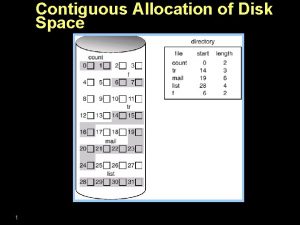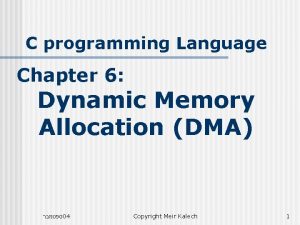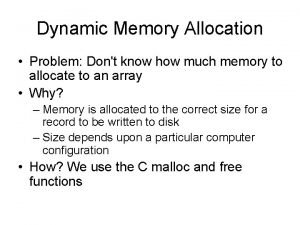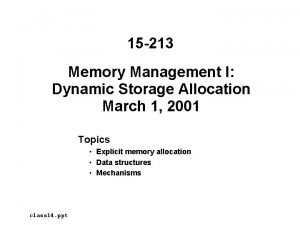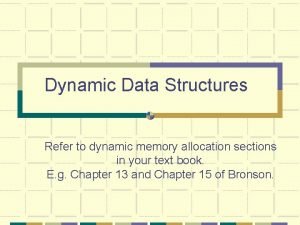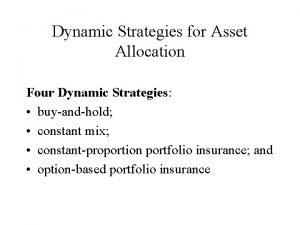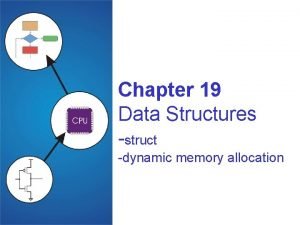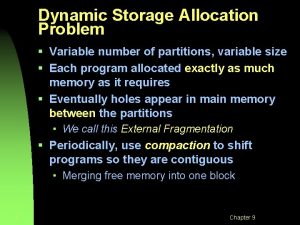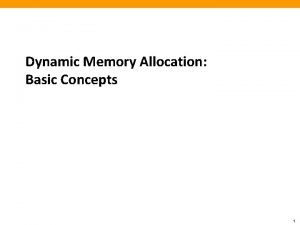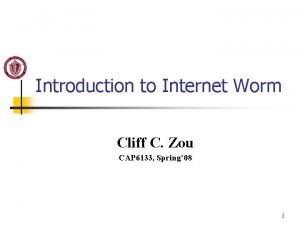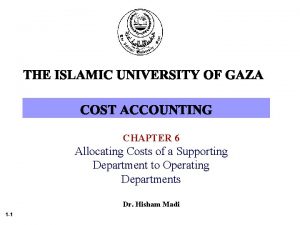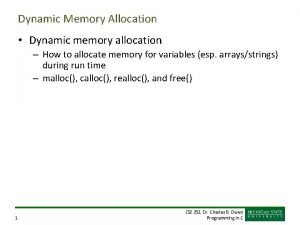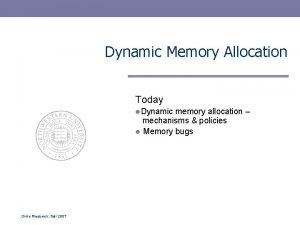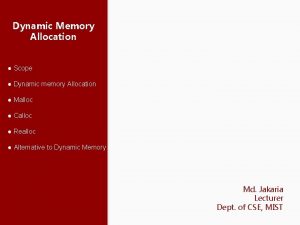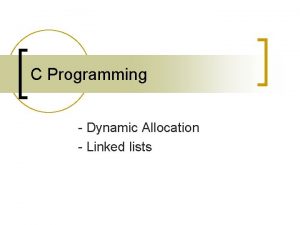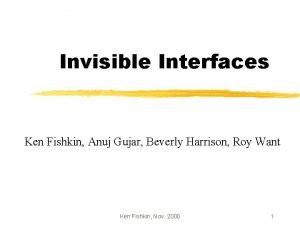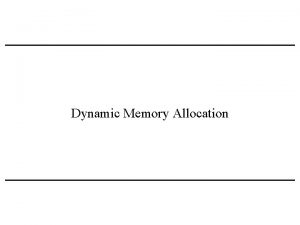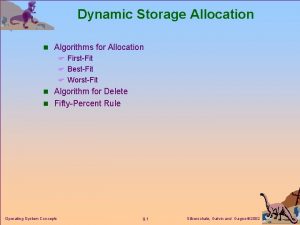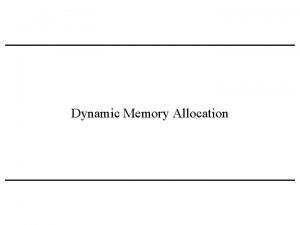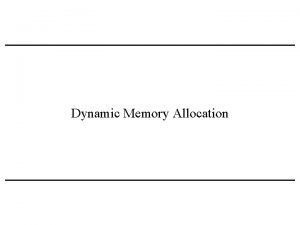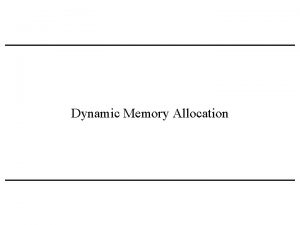Dynamic House Allocation Sujit Gujar 1 James Zou





































- Slides: 37

Dynamic House Allocation Sujit Gujar 1, James Zou 2 and David C. Parkes 2 5 th Multidisciplinary Workshop on Advances in Preference Handling (M-PREF 2010) August 16, 2010 1 Department of Computer Science and Automation Indian Institute 2 School of Engineering and Applied Sciences, Harvard University of Science

Agenda q Motivating Example q System Setup q State of The Art q Our Results q Experiments q Conclusion August 16, 2010 MPREF’ 10

Motivating Example Dynamic re-allocation of goods v University Dorms assignments v Office space re-allocation wherein agents arrive + depart dynamically

M T M August 16, 2010 MPREF’ 10

M T T August 16, 2010 MPREF’ 10 W

T W W August 16, 2010 MPREF’ 10

M T ? M T W W August 16, 2010 MPREF’ 10

Dynamic House Allocation § The above problem fits in dynamic house allocation framework § Object owned by an agent – house § Agents have private preferences § Agents arrive-depart dynamically § Agents may mis-report preferences to receive better house § We assume agents do not lie about arrival-departure periods § Feasibility: The allocation to agent i should be done within time window when he/she is present

Desirable Properties ü Strategyproof Mechanism is strategyproof if at all type profiles and at all arrivaldeparture schedules reporting preferences truthfully is dominant strategy equilibrium ü Individual Rationality (IR) Agent either receives better house than current one or keeps its own house ü Pareto Efficiency No other way of reallocation such that every agent is equally happy and at least one is strictly better off. ü Rank efficiency 1 Minimize expected rank of allocated houses 1 average true rank for allocated houses August 16, 2010 MPREF’ 10

State of the Art (Static Problem) August 16, 2010 MPREF’ 10

Top Trading Cycle Algorithm (TTCA)1 Ø Each agent points to his most preferred house among the available houses Ø Cycles – Trades Ø Remove all agents in the cycles Ø Continue till nobody is left 1 L. Shapley and H. Scarf, ‘On cores and indivisibility’, J. of Math. Econ. , 1(1), 23– 37, (1974).

A 1 h 2 > h 4 > h 3 > h 1 > h 5 A 2 A 4 h 3 > h 4 > h 5 > h 1 > h 2 A 3 A 1 A 3 h 2 > h 3 > h 1 > h 4 > h 5 A 4 A 2 h 5 > h 2 > h 3 > h 4 > h 1 A 5 h 1 > h 4 > h 2 > h 3 > h 5 August 16, 2010 MPREF’ 10

A 1 h 2 > h 3 > h 5 > h 1 > h 5 A 2 h 3 > h 4 > h 5 > h 1 > h 2 A 3 A 1 h 2 > h 3 > h 1 > h 4 > h 5 A 4 h 5 > h 2 > h 3 > h 4 > h 1 A 5 h 1 > h 4 > h 2 > h 3 > h 5 August 16, 2010 MPREF’ 10 A 4

A 1 h 2 > h 3 > h 5 > h 1 > h 5 A 4 A 2 h 3 > h 4 > h 5 > h 1 > h 2 A 3 h 2 > h 3 > h 1 > h 4 > h 5 Final house allocation: A 1 - h 5, A 2 -h 3, A 3 -h 2, A 4 -h 4, A 5 -h 1 A 4 h 5 > h 2 > h 3 > h 4 > h 1 A 5 h 1 > h 4 > h 2 > h 3 > h 5 August 16, 2010 MPREF’ 10

Static Case Results TTCA • Strategyproof 1 • Core (No subset of agents can improve • allocation) ⇒ Pareto optimality, IR Ma 2 – TTCA is unique mechanism that is strategyproof, individually rational and in the core 1 A. E. Roth, ‘Incentive compatibility in a market with indivisible goods’, Economics Letters, 9(2), 127– 132, (1982). 2 J. Ma, ‘Strategy-proofness and the strict core in a market with indivisibilities’, Int. J. of Game Theory, 23(1), 75– 83, (1994).

Coming to On-line Settings In on-line settings for the mechanisms we design: A simple strategyproof mechanism cannot use agent’s reported preference to decide at which time to let it participate in TTCA August 16, 2010 MPREF’ 10

Naïve Mechanism: On-line TTCA • In each period: The agents those are present, trade using TTCA • Fails to be strategyproof (For more than three agents and two or more period) August 16, 2010 MPREF’ 10

On-line TTCA fails to be strategyproof M T August 16, 2010 MPREF’ 10 ⅹ

On-line TTCA fails to be strategyproof M T ⅹ T August 16, 2010 MPREF’ 10

On-line TTCA fails to be strategyproof M T August 16, 2010 MPREF’ 10

On-line TTCA fails to be strategyproof M T T August 16, 2010 MPREF’ 10

Simple Mechanism (Informal) If there is perfect match set for an agent A, then occurrence of which guarantees the agent his most preferred house + agents different from A do not trade with the agents from perfect set (Note: ‘Simple Mechanism’ is not strong condition and the mechanism we design are simple) August 16, 2010 MPREF’ 10

Characterization Result If an online house allocation mechanism is SP and simple and agent A participates in TTCA in period t(>a) for some report >a , then fixing scenario w(0, t) in regard to all agents except A, agent A continues to participate in period t(>a) for all reports >a’. Informally, In any strategyproof, simple on-line house allocation mechanism, if agent A participates in TTCA trade in period t by reporting some preference, then he continues to participate in TTCA trade in the period t for any other report A simple strategyproof mechanism cannot use agent’s reported preference to decide at which time to let it participate in TTCA August 16, 2010 MPREF’ 10

Partition Mechanisms Partition agents into sets such that all the agents in a set are simultaneously present in some period The partition is independent of agent’s preference. May depend on arrival-departure periods Execute TTCA among the agents in each partition Each agent participate only once in TTCA Easy: Partition Mechanisms are strategyproof and IR August 16, 2010 MPREF’ 10

DO-TTCA, T-TTCA DO-TTCA (Departing agents On-line TTCA) Partition agents based on departure time (In period t, all agents with di = t trade) ⅹ a large number of agents that are present but may depart at distinct times T-TTCA (Threshold TTCA) If more than THRSHLD number of agents, that have not participated in TTCA, are present, execute TTCA with these agents. Otherwise, if there any departing agents, execute TTCA with such agents August 16, 2010 MPREF’ 10

SO-TTCA Stochastic Optimization TTCA Adopts a sample-based stochastic optimization 1 method for partitioning the agents § In each period, generate samples of possible future arrivaldeparture • For each sample, find an offline partition using greedy heuristic (the bigger the each set in the partition, the better) • For each agent, find out how often he is getting scheduled in the current period. Include the agent in current period if he is getting scheduled in current period more often than the fraction of agents yet to arrive 1 P. Van Hentenryck and R. Bent, Online Stochastic Combinatorial Optimization, MIT Press, 2006. August 16, 2010 MPREF’ 10

Partition Mechanisms are Simple • DO-TTCA, T-TTCA and SO-TTCA induce partition of the agents that is independent of the agents preference reports and hence partition mechanisms • DO-TTCA T-TTCA and SO-TTCA are simple mechanisms August 16, 2010 MPREF’ 10

Simulation Results (1 of 4) E 1: Poisson Arrival rate L = n/8 waiting period exponential distribution u = 0. 01 L SP Not SP Static August 16, 2010 MPREF’ 10

Simulation Results (2 of 4) E 2: Poisson Arrival rate L = n/8 waiting period exponential distribution u = 0. 1 L SP Not SP Static August 16, 2010 MPREF’ 10

Simulation Results (3 of 4) E 3: Uniform Arrival in period {1, 2, …, T} (T=30) Departure period uniform between {ai, ai+T/8} truncate to T if di > T SP Not SP Static August 16, 2010 MPREF’ 10

Simulation Results (4 of 4) E 4: Preferences are not skewed (Some houses are more demanded than other) Arrival Departure as in E 1 SP Not SP Static August 16, 2010 MPREF’ 10

Conclusion We have seen, For strategyproofness: agents cannot trade with different subsets of agents by changing their preference report Partition Mechanisms: SO-TTCA, T-TTCA out perform DO-TTCA Immediate question: What if agents can mis-report arrival-departure schedules? August 16, 2010 MPREF’ 10

Some details (Back up slides) August 16, 2010 MPREF’ 10

Preliminaries: q Instead of houses: Classes of houses (To avoid corner cases in the proofs) q Sample Path: w(>, ρ) An instance of an dynamic house allocation problem q w(t): Restriction of w(<, ρ) to the agents arrived before period t q w(t, t’): instance of reports of agents arrived in period [t, t’] q Λ: Perfect Match Set {Ai, hi, >i, t > ai, di} August 16, 2010 MPREF’ 10

Simple Mechanism A simple mechanism: Given a scenario w(0, t) and agent A available at t, there exists a perfect match set agents Λ = {Ai, hi, >A, t > a, d} such that (a)If a continuation w(t+) contains Λ, then A receives his most preferred house under the scenario (a) w(0, t)+w(t+), and (b) if B is present in w(0, t) and not similar to A then B does not trade with any agent in Λ August 16, 2010 MPREF’ 10

Important Result If an online house allocation mechanism is SP and simple and agent A participates in TTCA in period t(>a) for some report >a , then fixing scenario w(0, t) in regard to all agents except A, agent A continues to participate in period t(>a) for all reports >a’. A simple strategyproof mechanism cannot use agent’s reported preference to decide at which time to let it participate in TTCA August 16, 2010 MPREF’ 10

Partition Mechanism Simple DO-TTCA: For agent A (A, h 0, >A, a, d), the perfect match set: A set of n’ identical agents (A^, h^, >A^ , d, d) h^ : A most preferred house and A^ ’ s second most h 0 : A^ ’ s most preferred house and n’ : the number of agents similar to A T-TTCA and SO-TTCA are simple mechanisms August 16, 2010 MPREF’ 10
 Linked allocation
Linked allocation Dynamic c programming
Dynamic c programming Example of dynamic memory allocation
Example of dynamic memory allocation Dynamic memory allocation in java
Dynamic memory allocation in java Dynamic storage allocation
Dynamic storage allocation Example of dynamic memory allocation
Example of dynamic memory allocation Polymorphism dynamic allocation
Polymorphism dynamic allocation Knuth's boundary tags
Knuth's boundary tags Bandwidth ancoats
Bandwidth ancoats Dynamic data structure
Dynamic data structure Dynamic strategies for asset allocation
Dynamic strategies for asset allocation Pengertian pointer
Pengertian pointer Disadvantages of dynamic memory allocation
Disadvantages of dynamic memory allocation Malloc calloc free
Malloc calloc free Dynamic memory allocation in data structure
Dynamic memory allocation in data structure What is dynamic storage-allocation problem
What is dynamic storage-allocation problem Assumptions for dynamic channel allocation
Assumptions for dynamic channel allocation Tcmalloc
Tcmalloc Cliff zou
Cliff zou Cliff zou
Cliff zou Cliff zou
Cliff zou Miyu zou
Miyu zou Yi zhi zou
Yi zhi zou Changqing zou
Changqing zou Zou u zo vriendelijk willen zijn om engels
Zou u zo vriendelijk willen zijn om engels Transferered
Transferered Disorganized crime scene
Disorganized crime scene James russell odom
James russell odom They went house to house
They went house to house Snug bugs home
Snug bugs home Helel keller
Helel keller Banished boarding house vs house
Banished boarding house vs house Acceptance houses meaning
Acceptance houses meaning My house shall be called
My house shall be called Pachinko allocation
Pachinko allocation Support department adalah
Support department adalah Resource allocation graph in os
Resource allocation graph in os Incremental revenue allocation method
Incremental revenue allocation method
